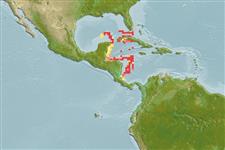Classification / Names
Common names from other countries
Main reference
Size / Weight / Age
Max length : 27.3 cm SL male/unsexed; (Ref. 91765)
Environment
Marine; bathydemersal; depth range 180 - 485 m (Ref. 34024)
Climate / Range
Deep-water, preferred ?; 25°N - 10°N, 90°W - 80°W (Ref. 91765)
Distribution
Western Atlantic: apparently restricted to the deep bank area east and northeast of Nicaragua and Honduras in the western Caribbean Sea and north of the Yucatan Peninsula in the southern Gulf of Mexico; not in the eastern Gulf of Mexico.
Countries | FAO areas | Ecosystems | Occurrences | Introductions
Short description
Dorsal
soft rays
(total): 140-147;
Anal
soft rays: 120 - 125;
Vertebrae: 80 - 83. This species is characterized by the following: usual number of vertebrae, precaudal 14-15, caudal 65-67, total 81-82 (80-83); usual number of fin rays, dorsal 142-145 (140-147), anal 120-125, pectoral 22-23); pyloric caeca usually 3 (rarely 4), 2 (rarely 3) in a single whorl, 1 in 2nd tier; first gill arch with rudimentary rakers 4 (rarely 3) on the upper arm, 8 developed (rarely 7) developed rakers on the lower limb, 0-3 (usually 0) rudimentary rakers anteriorly on the first arch; total rakers 12 (usually 11-14); dorsal-fin origin between neural spines 4-5 (11 specimens) or 5-6 (6 specimens) (Ref. 91765).
IUCN Red List Status (Ref. 115185)
Threat to humans
Harmless
Human uses
More information
Age/SizeGrowthLength-weightLength-lengthLength-frequenciesMorphometricsMorphologyLarvaeLarval dynamicsRecruitmentAbundance
ReferencesAquacultureAquaculture profileStrainsGeneticsAllele frequenciesHeritabilityDiseasesProcessingMass conversion
Tools
Special reports
Download XML
Internet sources
Estimates of some properties based on models
Phylogenetic diversity index
PD50 = 0.5000 many relatives (e.g. carps) 0.5 - 2.0 few relatives (e.g. lungfishes)
Trophic Level
3.6 ±0.7 se; Based on size and trophs of closest relatives
Resilience
Medium, minimum population doubling time 1.4 - 4.4 years (Assuming tmax>3)
Vulnerability
Low to moderate vulnerability (33 of 100)
Price category
